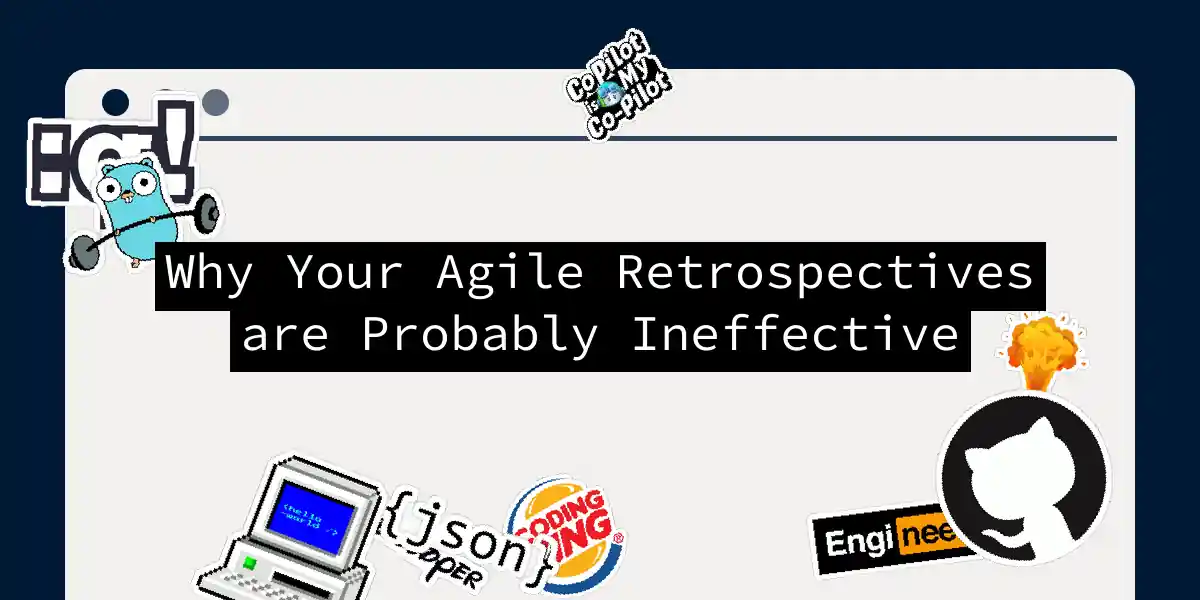The Retrospective Rut: Why Your Agile Retros Are Falling Flat
Agile retrospectives are meant to be the heartbeat of your team’s continuous improvement, but often they end up feeling like a chore, a box-ticking exercise, or worse, a complete waste of time. If you’re nodding your head in agreement, you’re not alone. Here are some common pitfalls that might be turning your retros into a snooze fest, and more importantly, how you can revitalize them.
No Preparation: The Recipe for Disaster
Imagine walking into a kitchen to cook a meal without any ingredients or a recipe. That’s what happens when you show up to a retrospective without any preparation. It’s a surefire way to ensure that your discussion meanders aimlessly, leading to frustration and a lack of tangible outcomes.
To avoid this, take some time to prepare an agenda. Here’s a simple flowchart to help you get started:
Lack of Clear Leadership and Focus
Without clear leadership, your retrospective can quickly devolve into chaos. It’s crucial to have someone who can guide the discussion, keep it on track, and ensure that everyone’s voice is heard. This leader should also help the team sharpen their focus, making sure that the discussion is centered around specific, relevant issues rather than general complaints.
For example, if the team struggled with under-defined user stories in the previous sprint, the focus could be on “improving our work with the product owner to groom the backlog.”
Information Smoothie vs. Information Salad
Ever tried to solve a problem by throwing all the symptoms, causes, and solutions into a blender and hitting puree? That’s what happens when you create an “Information Smoothie” – a mess that’s hard to decipher and act upon. Instead, aim for an “Information Salad” where each component is clearly identified and separated.
Here’s how you can visualize this:
No Action Items: The Road to Nowhere
Retrospectives without clear action items are like New Year’s resolutions without a plan – they sound good but never materialize. The point of a retrospective is not just to complain or celebrate; it’s to identify opportunities for improvement and assign tasks to make those improvements happen.
Here are some tips for managing action items effectively:
- Record and Store: Write down the action items and store them in a visible place, such as a team wiki or a board where everyone can see them.
- Assign Responsibilities: Clearly assign who is responsible for each action item.
- Follow Up: Regularly follow up on these action items in subsequent retrospectives.
Meetings That Drag On
Meetings that go over time are a surefire way to kill engagement. When your retrospective drags on, it disrespects everyone’s time and drains energy. It’s essential to stick to the schedule and incorporate breaks to keep the conversation fresh and relevant.
Here’s a simple sequence diagram to illustrate the importance of timing:
Focusing on the Wrong Things
Sometimes, teams get caught up in discussing impediments that are outside their control. This can lead to frustration and a sense of helplessness. Instead, focus on what the team can control and improve. For instance, if the team is struggling with poorly defined user stories, focus on improving the backlog grooming process rather than complaining about the product owner’s lack of involvement.
The “Worst Idea” Technique: A Fresh Perspective
If your retrospectives are feeling stale, try the “Worst Idea” technique. Instead of focusing on what went well or what could be improved, explore the worst-case scenarios that could derail your progress. This technique encourages an honest examination of genuine concerns and potential threats based on past experiences or current project dynamics.
Here’s how you can set the stage for this technique:
The Importance of Follow-Up
Finally, the most critical aspect of any retrospective is the follow-up. If the action items are not integrated into the team’s regular workflow, they will likely be forgotten. Make sure to write story cards for the chosen improvements and include them in the next iteration planning meeting. This way, improving the team’s capability becomes part of the “real work”.
In conclusion, Agile retrospectives are a powerful tool for continuous improvement, but they can easily fall into ineffective patterns. By preparing well, maintaining focus, avoiding the “Information Smoothie,” ensuring clear action items, keeping meetings on track, focusing on controllable improvements, and using innovative techniques like the “Worst Idea” method, you can revitalize your retros and make them a valuable part of your team’s growth.
So, the next time you’re about to start a retrospective, remember: it’s not just about looking back; it’s about building momentum for the future. And if all else fails, just recall the number one retrospective anti-pattern – not having one at all. Because, as the saying goes, “if you don’t stop to look around once in a while, you could miss it.”
